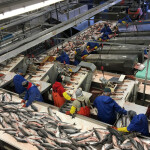The United Fishermen of Alaska (UFA) is forging ahead with an effort to rally support for creating a national seafood-marketing program to bolster consumer awareness, and potentially consumption, of domestic seafood.
Still in the early stages, the effort is currently focused on forming a national seafood marketing coalition, Julie Decker, who's among the four contractors the UFA hired to spearhead the effort, told SeafoodSource.
"The coalition is designed to build the broad-based support that we would need to get legislation, or any changes to legislation, through Congress," said Decker, a gillnet salmon fishermen with her husband, Gig, in Wrangell, Alaska. "With the political environment that we're in, we need a broad base of support. We need everyone saying, ‘Yes, this is for all of us.'"
The UFA has already received letters supporting the coalition's formation from the Southern Shrimp Alliance, Chesapeake Bay Seafood Industries Association, Massachusetts Lobstermen's Association, Maine Lobster Promotion Council and Alaska Seafood Marketing Institute. Additionally, a resolution backing the coalition, submitted by Alaska Sen. Dennis Egan of Juneau in early March, is awaiting a final vote in the Alaska Legislature.
"We're finding that people in every region have their own set of problems, whether it's allocation, resource management, resource depletion or competition with imports," said Decker, also an Alaska Fisheries Development Foundation board member. "But when you talk to them about a national seafood marketing campaign, everyone says, ‘Yes, that sounds good.' Everyone sees that that would be helpful to them. So it wasn't as challenging as we thought it would be."
Later this month, Decker and other UFA representatives are meeting with the Northwest Fisheries Association in Seattle, Commercial Fishermen of America in San Francisco, American Albacore Fishing Association in Bonita, Calif., West Coast Seafood Processors Association in Portland, Ore., and United Catcher Boats in Seattle, as well as the National Fisheries Institute in McLean, Va.
A steering committee is in the works to help with outreach and the coalition's formation, added Decker.
Step No. 2 of the six-step process is to establish a national seafood-marketing fund; a portion (about USD 100 million) of the hundreds of millions in revenues generated annually by U.S. antidumping duties on seafood imports would be directed into the fund. Currently, revenues from antidumping duties are deposited into the U.S. Treasury and then distributed to the National Marine Fisheries Service, the Saltonstall-Kennedy Grant Program and others.
Step No. 3 is to identify a legislative vehicle to attach the fund to, and step No. 4 is to set up nine regional boards to develop marketing goals and allocate funding.
"The key reason why this approach will be successful is the regional boards, [which] decide how the money is to be [distributed]," said Decker. "They're not out there trying to market seafood. They're just administering the money to [existing organizations] that will market seafood. We think that'll give it more localized control."
Decker said she's pleased with the effort's progress so far and is optimistic about its future.
"We're further along than we thought we'd be when we started down this road," she said. "We didn't know what kind of shape this would take. But we've made faster progress than we had hoped. We're very encouraged. It's a large feat to accomplish, but we think we can get there."
Can U.S. per-capita seafood consumption break the 17-pound mark, or even the 18-pound mark, in the near term?
"I think that's something this program could help do," said Decker.
April 4, 2010





